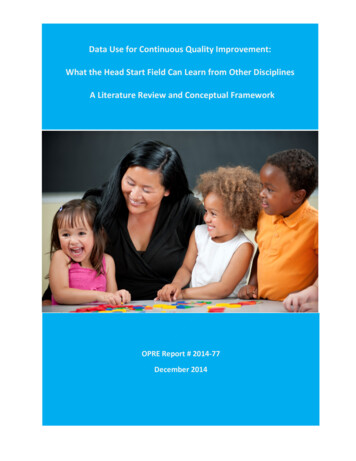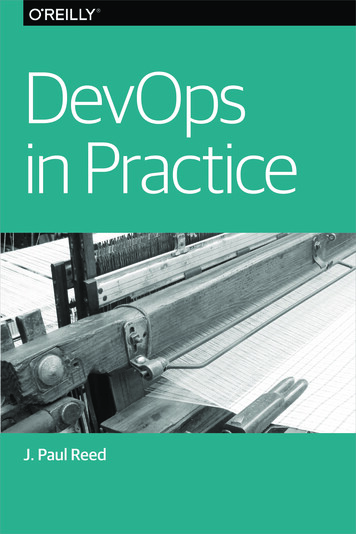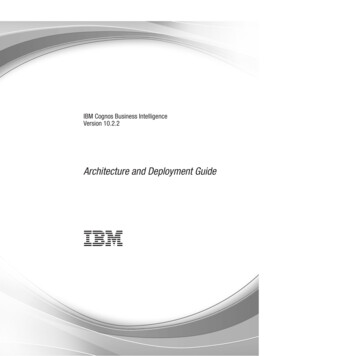
Transcription
Data Use for Continuous Quality Improvement:What the Head Start Field Can Learn from Other DisciplinesA Literature Review and Conceptual FrameworkOPRE Report # 2014-77December 2014
DATA USE FOR CONTINUOUS QUALITY IMPROVEMENT: WHAT THE HEAD START FIELD CAN LEARNFROM OTHER DISCIPLINES. A LITERATURE REVIEW AND CONCEPTUAL FRAMEWORKFINAL REPORTOPRE Report # 2014-77December 2014Teresa Derrick-Mills, Heather Sandstrom, Sarah Pettijohn, Saunji Fyffe, and Jeremy Koulish, The UrbanInstituteSubmitted to:Jennifer Brooks and Mary Bruce WebbOffice of Planning Research and EvaluationAdministration for Children and FamiliesU.S. Department of Health and Human ServicesContract Number: HHSP23320095654WC, Order Number: HHSP233370038TProject Director: Teresa Derrick-MillsThe Urban Institute2100 M Street NWWashington, DC 20037This report is in the public domain. Permission to reproduce is not necessary. Suggested Citation:Derrick-Mills, Teresa, Heather Sandstrom, Sarah Pettijohn, Saunji Fyffe, and Jeremy Koulish. (2014). DataUse for Continuous Quality Improvement: What the Head Start Field Can Learn From Other Disciplines, ALiterature Review and Conceptual Framework. OPRE Report # 2014-77. Washington, DC: Office ofPlanning, Research and Evaluation, Administration for Children and Families. U.S. Department of Healthand Human Services.DisclaimerThe views expressed in this publication do not necessarily reflect the views or policies of the Office ofPlanning, Research and Evaluation, the Administration for Children and Families, or the U.S. Departmentof Health and Human Services.This report and other reports sponsored by the Office of Planning, Research and Evaluation are availableat http://www.acf.hhs.gov/programs/opre.Cover photo iStock.com/CEFutcher.ii
AcknowledgementsWe would like to acknowledge our project officer at the US Department of Health and Human Services(DHHS), Office of Planning, Research and Evaluation (OPRE), Mary Bruce Webb; our former projectofficers Jennifer Brooks and Mary Mueggenborg; and Society for Research on Child DevelopmentFellows Nina Philipsen Hetzner and Kelly Fisher. We also thank the Office of Head Start. We appreciatethe input of Urban Institute research team members Monica Rohacek, Olivia Healy, and Eleanor Pratt,and the input of Urban Institute senior advisors Elizabeth Boris, Carol De Vita, Harry Hatry, and MaryWinkler.Expert Workgroup MembersWe would like to thank the following members of the Head Start Leadership, Excellence, and DataSystems Expert Workgroup. The views expressed in this publication do not necessarily reflect the viewsof these members.Isaac CastilloSenior Research ScientistChild TrendsSusan CatapanoChair, Watson College of Education,University of North Carolina at WilmingtonPaula Jorde BloomMichael W. Louis Endowed ChairMcCormick Center for Early Childhood LeadershipAnne KhademianDirector, School of Public and International Affairs,Virginia TechLori MelicharSenior Program OfficerRobert Wood Johnson FoundationJodi SandfortChair, Leadership & Management AreaHumphrey School of Public Affairs,University of Minnesotaiii
OverviewThis literature review and conceptual framework was produced as part of the Head Start Leadership,Excellence, and Data Systems project. The Office of Planning, Research and Evaluation contracted withthe Urban Institute in 2012 to develop a set of items that would help Head Start researchers betterunderstand how to examine issues related to data use for continuous quality improvement incommunity-based Head Start programs. Other products include (1) a report and briefs on data usepractices and challenges in the Head Start field based on interviews with Head Start programs and (2) atoolkit to help improve practice based on the interviews and literature.The literature review was coauthored by a group of researchers at the Urban Institute. The conceptualframework was developed by that same group of researchers and validated by a panel of experts fromthe disciplines in which the literature was reviewed, as well as experts from the early care and educationfield. This review draws from the empirical and professional research of many fields to create aninformed base from which Head Start can build its own research and improved practice in data use forcontinuous quality improvement.The review reflects seminal and current works that originate in empirical and professional sources in thefields of educational leadership and management, health care management, nonprofit leadership andmanagement, public management, and organizational learning and development. The literaturesummarized here includes research found in peer-reviewed journals; reports from foundation-fundedevaluations and pilot projects; government-sponsored reports; and practitioner-targeted books, blogposts, and other materials. We were intentionally broad in the sources included because much of theknowledge in the field of data use for quality improvement comes from practitioner-oriented workrather than formal research studies.This literature review encompasses the following elements that may support or impede data use forcontinuous quality improvement and represents these elements in a conceptual framework: LeadershipAnalytic capacityCommitment of resourcesProfessional developmentCulture of collaborative inquiryContinuous cycleEnvironmental and organizational characteristicsiv
Executive SummaryThis review summarizes research on the processes, facilitators, and impediments to data use forcontinuous quality improvement; develops a conceptual framework representing the elements of datause for continuous quality improvement; and provides linkages between the disciplines from which theliterature was drawn and the Head Start field. The review reflects seminal and current works thatoriginate in empirical and professional sources in the fields of educational leadership and management,health care management, nonprofit leadership and management, public management, andorganizational learning and development. The literature summarized includes research found in peerreviewed journals; reports from foundation-funded evaluations and pilot projects; governmentsponsored research; and practitioner-targeted books, blog posts, and other materials. We wereintentionally broad in the sources included because much of the knowledge in the field of data use forquality improvement comes from practitioner-oriented work rather than formal research studies.Conceptual FrameworkThe key principles that emerged from the scholarly and applied literature reviewed for this study wereintegrated to construct a conceptual framework. Specifically, the conceptual framework depicts thefollowing eight elements posited to facilitate or impede the process of data use for continuous qualityimprovement: leadership, commitment of resources, analytic capacity, professional development, aculture of collaborative inquiry, a cycle of continuous quality improvement, organizationalcharacteristics, and the environment.It is important to note that research across the fields tends to be exploratory rather than causal. Studiesare typically designed to identify characteristics of organizations or programs that have been successfulin implementing data use for quality improvement. The studies typically do not explore the relationshipsbetween the characteristics, and most of the studies do not examine whether quality was actuallyimproved. Some of the studies focus on the barriers to implementing data use for quality improvement;some focus on facilitators. Thus, this research helps us identify facilitators and challenges withinprograms and organizations, but it does not tell us which characteristics or combinations ofcharacteristics are most important to success.Key FindingsSix key findings emerged from the literature. These six findings informed the eight elements embodiedin the conceptual framework. The report has been organized around the key findings. In each section,we identify and discuss the literature that supports that finding, organized by the elements of theconceptual framework. Additionally, we discuss how to translate the interdisciplinary knowledge for usein Head Start. At the end of the report, we summarize implications for Head Start research incommunity-based Head Start programs.v
1. Leaders must be strong, committed, inclusive, and participatory.The evidence suggests that leadership both in formal roles and across the organization from staff not informal leadership roles (distributed leadership) can be important. Only a few studies examine therelevance of governing board members, and the evidence in those studies on the importance ofgoverning board interest and involvement in data use is mixed. Key findings from the literature include: Effective leaders are transformational, serving as role models for data use in decision-making(Berwick 1996; Copland 2003; Cousins, Goh, and Clark 2006; Daly 2012; Hatry and Davies 2011;Honig and Venkateswaran 2012; Kaplan et al. 2010; Kee and Newcomer 2008; Mandinach,Honey, and Light 2006; Means, Padilla, and Gallagher 2010; Moynihan, Pandey, and Wright2012; Morino 2011; Park and Datnow 2009; Sharratt and Fullan 2012; Van Wart 2003).Effective leaders distribute leadership responsibilities among staff, motivating staff to use dataand contribute to decision-making processes (Brown 2011; Copland 2003; Devers 2011; Harris etal. 2007; Kabcenell et al. 2010; Levesque, Bradby, and Rossi 1996; Park and Datnow 2009;Reinertsen, Bisogano, and Pugh 2008).Effective leaders clearly communicate their expectations around data use (Berwick 1996; Daly2012; Honig and Venkateswaran 2012; Mandinach, Honey, and Light 2006; Sanger 2008).Governing bodies may contribute to increased data use by demonstrating their interest in dataand continuous improvement efforts, but evidence on governing body influence is mixed(Blumenthal and Kilo 1998; Kaplan et al. 2010; Reinertsen, Bisogano, and Pugh 2008).2. Analytic capacity is necessary, and should not be assumed.The literature typically discusses analytic capacity as a barrier to, rather than a facilitator of, data use.Analytic capacity includes the available data, technology, and staff knowledge. Key findings from theliterature include: Analytic capacity may be grouped into three primary buckets—appropriate data, appropriatetechnology, and human capacity.Appropriate data are quality observations, information, and numbers that can be aggregatedand sorted to provide meaningful insights for decision-making. Specific decisions require specifictypes and levels of data (Bernhardt 2003, 2009; Hatry et al. 2005; Hatry and Davies 2011; Kellyand Downey 2011; Means, Padilla, and Gallagher 2010; Moynihan 2007; Poister 2004; Roderick2012; Supovitz 2012; Wholey 2001).Appropriate technology allows for efficient data collection, secure data storage, data sorting andaggregating, and appropriate data analyses to provide meaningful and timely insights fordecision-making (Bernhardt 2003; Hatry and Davies 2011; Mandinach, Honey, and Light 2006;Means, Padilla, and Gallagher 2010; Marsh 2012).Human capacity refers to the extent to which the staff understand (1) what appropriate dataare, (2) how to analyze and make meaning from the data, and (3) how to use the data inmeaningful ways to improve the quality of their work (Bernhardt 2003; Blumenthal and Kilo1998; Copland 2003; Daly 2012; Hatry et al. 2005; Hatry and Davies 2011; Idealware 2012;vi
Marsh 2012; Park and Datnow 2009; Poister 2004; Sanger 2008; Sharratt and Fullan 2012;Wholey 2001).3. Leaders must prioritize and commit time and resources to the data-use effort.Leaders must not only possess certain characteristics, but they must also demonstrate theircommitment to data use for continuous quality improvement by channeling resources to support andsustain technology; devoting their time to these efforts; developing staff knowledge; and increasing staffability to collect, analyze, and use data appropriately. The key findings from the literature include: Leaders must prioritize their own time to participate directly in the data-use efforts (Blumenthaland Kilo 1998; Forti and Yazbak 2012; Hatry and Davies 2011; Honig and Venkateswaran 2012;Kabcenell et al. 2010; Means, Padilla, and Gallagher 2010; Park and Datnow 2009; Sanger 2008).Leaders must recognize that staff time is required to collect, enter, examine, and use data(Bernhardt 2009; Daly 2012; Hendricks, Plantz, and Pritchard 2008; Honig and Venkateswaran2012; Idealware 2012; Means, Padilla, and Gallagher 2010; Park and Datnow 2009; Sanger2008).Leaders must allocate resources to technology needed to house and analyze data (Hendricks,Plantz, and Pritchard 2008; Hoefer 2000; Idealware 2012; Park and Datnow 2009; Sanger 2008).Professional development of staff to facilitate understanding, analyzing, and using data isneeded in the same way that staff need professional development in their particular areas ofspecialization (child development, parent education, nutrition, health care, curriculumassessment, etc.) (Berthleson and Brownlee 2007; Cousins, Goh, and Clark 2006; Curtis et al.2006; Honig and Venkateswaran 2012; Kabcenell et al. 2010; Kelly and Downey 2011; Lipton andWellman 2012; Little 2012; Mandinach, Honey, and Light 2006; Marsh 2012; Means, Padilla, andGallagher 2010; Park and Datnow 2009; Reinertsen, Bisogano, and Pugh 2008; Rohacek, Adams,and Kisker 2010; Sanger 2008).4. An organizational culture of learning facilitates continuous data use.A learning culture is evidenced by a safe space where staff can openly discuss whatever the data mightreveal about program operations and outcomes—good or bad—without fear of reprisal. Learningcultures also create opportunities for shared learning where staff can discuss data together todetermine what the data mean and what to do about it. Finally, learning cultures attempt to involveboth staff and stakeholders, typically clients, in making sense of the data and determining where tofocus improvement efforts. The key findings from the literature include the following: An organizational culture that values learning facilitates continuous data use for qualityimprovement (Berwick 1996; Blumenthal and Kilo 1998; Hatry et al. 2005; Hendricks, Plantz, andPritchard 2008; Hoefer 2000; Honig and Venkateswaran 2012; Idealware 2012; Lipton andWellman 2012; Morino 2011; Moynihan, Pandey, and Wright 2012; Sanger 2008; Wholey 2001).Creating safe spaces and facilitating shared learning through reflection on and interpretation ofdata demonstrate a culture that values learning (Berlowitz et al. 2003; Bernhardt 2009; Berwickvii
1996; Blumenthal and Kilo 1998; Copland 2003; Crossan, Lane, and White 1999; Daly 2012; Fortiand Yazbak 2012; Hatry and Davies 2011; Honig and Venkateswaran 2012; Kabcenell et al. 2010;Kaplan et al. 2010; Lipton and Wellman 2012; Little 2012; Marsh 2012; Means, Padilla, andGallagher 2010; Morino 2011; Park and Datnow 2009; Torres and Preskill 2001; Schilling andKluge 2008; Weick, Sutcliffe, and Obstfeld 2005).Engaging stakeholders in a process of shared learning is another element of a learning culture(Forti 2012; Kabcenell et al. 2010; Reinertsen, Bisogano, and Pugh 2008; Robinson 2011; Sanger2008).5. Data use for quality improvement is a continuous process.Reflecting on organizational and program goals, data users identify the data they have and the questionsthey want to address. They collaboratively analyze the data and interpret the findings. With theexpertise and experience of the data user, the information becomes knowledge. That knowledge tellsthe user how the program is performing, and which areas of the program need improvement. Theseareas are prioritized to create a concrete action. During implementation, observations and data are fedback into the continuous improvement loop so that progress toward goals and performance objectivescan be monitored. Progress and quality are evaluated against internal goals or external benchmarks. Theend of every cycle is the beginning of a new cycle. The key finding from the literature is the following: Effective data use to improve quality requires a continuous cyclical process of goal-setting, datacollection, data examination, and data use (Bernhardt 2009; Berwick 1996; Blumenthal and Kilo1998; Hatry and Davies 2011; Levesque, Bradby, and Rossi 1996; Lipton and Wellman 2012;Mandinach, Honey, and Light 2006; Means, Padilla, and Gallagher 2010; Morino, 2011; Sharrattand Fullan 2012; Torres and Preskill 2001).6. The environment matters. It, too, is complex and dynamic.The literature points to two primary contextual elements that appear to influence the use of data toimprove quality in programs: the organization in which the program operates and the largerenvironment in which the organization operates. Key findings from the literature include: Programs exist within organizations. Organizational characteristics such as size, structure(Berwick 1996; Blumenthal and Kilo 1998; Daly 2012; Forti and Yazbak 2012; Honig andVenkateswaran 2012; Idealware 2012; Means, Padilla, and Gallagher 2010), and history ofefforts (Blumenthal and Kilo 1998; Copland 2003; Forti and Yazbak 2012; Means, Padilla, andGallagher 2010) may influence the extent to which, and how, supports for data use are providedand data are used.Organizations exist within policy and regulatory environments, accreditation and licensingrequirements, governmental and nongovernmental funders, and professional communities.Types of data collected and used are influenced by these entities (Blumenthal and Kilo 1998;Copland 2003; Curtis et al. 2006; Daly 2012; Derrick-Mills 2012; Derrick-Mills and Newcomer2011; Forti 2012; Gunzenhauser et al. 2010; Hendricks, Plantz, and Pritchard 2008; Hoefer 2000;viii
Honig and Venkateswaran 2012; Idealware 2012; Kaplan et al. 2010; Kee and Newcomer 2008;Mandinach, Honey, and Light 2006; Means, Padilla, and Gallagher 2010; Morino 2011; Rohacek,Adams, and Kisker 2010; Weiner et al. 2006).Policies, regulations, requirements, and community values evolve and therefore have differinginfluences on the practices or organizations and programs at different points in time (DerrickMills 2012).Implications for Head Start ResearchThis interdisciplinary literature review and resulting conceptual frame (figure 3) provide a starting placefor examining data use for quality improvement in Head Start programs. Head Start programs are similarin many ways to (1) the schools and school systems investigated in the educational leadership andmanagement literature, (2) the governmental organizations described in the public managementliterature, and (3) the nonprofit organizations explored in the nonprofit management literature. Theinterdisciplinary review reveals that across all the fields, there are some common barriers andfacilitators to data use for quality improvement.Reflecting on the similarities of Head Start programs to the other organizations studied indicatesthat Head Start researchers can draw directly from the framework in their examination of Head Start.Head Start’s similarities with governmental organizations, nonprofits, and school districts suggest that itis likely to face similar challenges in moving from data systems and a culture developed to meet externalaccountability requirements to systems and a culture designed to foster internal learning. The literaturesuggests that like these other organizations, Head Start programs would benefit from transformationalleaders to support the transition.However, community-based Head Start programs have three key characteristics not explored inthe literature that Head Start researchers need to consider as they design studies: prescriptive roles,programs within organizations, and grantee-delegate/grantee-child care partnerships. Although many ofthe programs studied face prescriptions from their funders, the defined roles of the Policy Council,governing bodies, and leadership positions in Head Start exceed that level of prescription. Additionally,local Head Start programs are often embedded within larger organizations, and the relationship of theprogram to the organization needs to be explored. Similarly, Head Start programs often operate througha network of organizations—grantees, delegates, and child care partnerships. Researchers will need tocarefully examine those dynamics.Finally, the conceptual framework implies relationships between elements, but thoserelationships have not been tested. Head Start research should examine how the elements representedin the framework reflect the facilitators and impediments to data use in Head Start programs, buttesting of relationships would better position the Office of Head Start to help Head Start programsimprove practice.ix
Table of ContentsExpert Workgroup Members . iiiOverview . ivExecutive Summary. vKey Findings . vImplications for Head Start Research . ixList of Tables . xiI. Introduction . 1Purpose . 1Focus of Literature Review . 2Organization of this Paper .II. History of Data Use for Continuous Quality Improvement. 3III. Methods . 6Literature Review Overview. 6Limitations . 7Strengths. 7Developing a Research-Based Conceptual Framework . 7IV. The Conceptual Framework. 81. Leaders must be strong, committed, inclusive, and participatory . 12Key Findings from the Literature . 12Reflecting on Head Start and Leadership . 152. Analytic capacity is necessary, and should not be assumed. 15Key Findings from the Literature . 15Reflecting on Head Start and Analytic Capacity . 193. Leaders must prioritize and commit time and resources to the effort. . 21Key Findings from the Literature . 21Reflecting on Head Start, Commitment of Resources, and Professional Development . 274. An organizational culture of learning facilitates continuous data use. . 28Findings from the Literature. 28Reflecting on Head Start and Organizational Culture . 30x
5. Data use for quality improvement is a continuous process. . 31Findings from the Literature. 31Reflecting on Head Start and the Continuous Cycle. 336. The environment matters. It, too, is complex and dynamic. . 36Findings from the Literature. 36Reflecting on Head Start and Its Environment . 41V. Conclusions and Implications for Head Start . 45References . 65Appendix A: Description of Literature Review Methods . 49Appendix B: Interview Protocol for Experts to Guide Literature Review . 55Appendix C: Literature Coding Structure . 57Appendix D: Steps in Development of the Conceptual Framework . 59Appendix E: Conceptual Framework Elements by Supporting Sources. 62List of TablesTable 1. Number of Sources by Field and Framework ElementTable 2. Types of Data Useful for Performance Assessments and ImprovementsTable 3. Presence of Data Support Elements by Statistically Significant Differences in District SizeTable A.1. Search Terms by Discipline and ConstructTable A.2. Sources and Methods by DisciplineTable D.1. Emergent Findings and ConstructsTable E.1. Conceptual Framework Elements by Supporting SourcesList of FiguresFigure 1. Plan-Do-Study-Act Cycle of Quality ImprovementFigure 2. DIKW PyramidFigure 3. Continuous Quality Improvement Conceptual FrameworkFigure 4. Example of Multiple Continuous Data Loops Linked Together Toward a Common Goalxi
I. IntroductionPurposeA growing body of research highlights the key components of high-quality early care and education.Much of this work focuses on enhancing the quality of classroom environments and teacher-childinteractions (Caronongan et al. 2011; Lloyd and Modlin 2012; Mattera et al. 2013; Moiduddin et al.2012; Peck and Bell, 2014), with little attention to the organizational and management processes thatsupport continuous quality improvement. Teachers, however, work in environments that are largelymanaged by others; decisions about curriculum, goals for achievement, data systems for trackinginformation about child progress, professional development opportunities, and many other factors aretypically made outside the classroom.In Head Start programs, decisions about how to run each program are guided by the federalrequirements enforced by the Office of Head Start, while support is provided by the many technicalassistance centers. Monitoring to assure that Head Start programs meet standards for childdevelopment, governance, parental engagement, health, nutrition, etc. has long been a part of thecompliance structure. As part of their federal requirements, Head Start programs are already collectingdata about the characteristics of the children and families they serve, the developmental levels andneeds of children, enrollment and attendance in their programs, community needs, and the timeperiods in which they provide required services. They report some of these data to the Office of HeadStart. However, the extent to which they are using these or other data internally to make informeddecisions to improve program quality is not clear.Both the 2007 reauthorization of Head Start and the recent implementation of the Head StartDesignation Renewal System place an increased emphasis on the role of ongoing assessments ofchildren and the use of data about children’s school readiness for program improvement. Under theHead Start Designation Renewal System, grantees’ ability to demonstrate that they are monitoringchildren’s school readiness and using those data to improve the program over time is one of sevencriteria used to determine whether a grantee must compete for its funding. Yet, to date we know little—either in Head Start or the broader early childhood literature—about how programs understand and usedata about the program and the children they serve in program planning.To that end, the Office of Planning, Research and Evaluation contracted with the Urban Institutein 2012 to conduct the Head Start Leadership, Excellence, and Data Systems project. The goal of theHead Start Leadership, Excellence, and Dat
continuous quality improvement; develops a conceptual framework representing the elements of data use for continuous quality improvement; and provides linkages between the disciplines from which the literature was drawn and the Head Start










